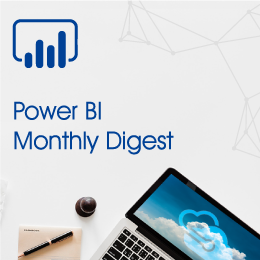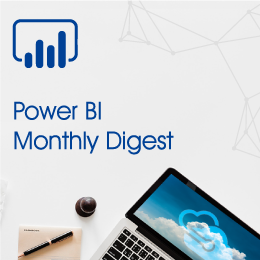Power BI Monthly Digest - March 2019


Welcome to our Power BI Digest for March where we discuss our favorite new features or updates within Power BI. As always, we do a brief demo of the features we discuss, so be sure to watch the video included here to see these in action!
We’ve got some enhancements on the data visualization side, a few new DAX functions on the modeling side and announcing some features that were in preview that are now generally available.
Let’s start with visualizations:
1. Slicers – This is an old favorite that’s perfect for giving us an option to apply a filter to our visuals. They’ve added a small aesthetic element to slicers around single selections. This new element is only available in the list or drop-down option for the slicer.
In our example I will bring in the slicer visual and use Calendar Year for the value. By default, it will use the range slicer option and then I can switch that to the list option, which is probably too plain and simple for most.
But I can go into the format area and under the selection controls we have the ‘Single select’ option, which has always been there. But here’s the difference, when I turn that on, the presentation will change; all my multi-select options go away and I now have a radial-button look and feel.
If we switched this to a drop down, we’ll get presented with the same radial button look.
2. Storytelling/Selection Pane – Oftentimes people get frustrated with the Selection Pane as you have a big list of all the objects that are in your report. Many times, these will have the same or very similar names, so it can be difficult to differentiate between them. This new feature comes from requests from the Power BI community.
Now, we can simply double-click on the item itself and can rename it which is effectively changing the Title option. If visuals already have a title, this will amend what is seen in the visual tile to our new title. For things like buttons, images, matrices or tables that don’t have a title by default, you won’t see any impact. But note that if you do make a change, it is changing the value for the title option.
When I open the selection pane, I have 3 items and if I add more objects, like a couple buttons for instance, regardless of the number of buttons or images I bring in, it will be listed as a button or image. So, how do you know what you need from a hiding and showing perspective?
With this new enhancement, I can just click on a button or image listed in the pane and change the title to clearly identify what each one is. If I want to change a table name, I can click on it in the pane, put in a new title and the title presented to the users will change.
The main point on this one is about hiding and showing report objects, so as we start to dive into digital storytelling, this will make that process easier, which is great!
3. Tool Tips – Tools tips have seen quite a bit of changes over time. This month they’ve updated the default tool tips (not the report page tool tips) where you have additional capability of formatting beyond what was there.
One of the nicest built in elements of Power BI is that users can hover over things you’ve put in visuals and get a tool tip. We’ve had great enhancements for formatting, backgrounds and wallpapers, among others, and now we have the ability of formatting the actual tool tip that presents itself.
When you hover over a tool tip, they have the traditional black background with a grey text for the item and a bolder white text for the value of it. All of that is now configurable.
Simply select the visual you want and under Format, go to the Tool Tip area. You’ll see added fields for the label and value color. We can also modify the background color, text size and font family. A nice way to enhance your visuals when using Tool Tips.
4. Actions – Just as you can make Actions that allow you to jump from one place to another in your reports, now you can use Actions to jump to a URL. We’ve always been able to jump to a Bookmark or Q&A with buttons or images. Now you can add a button for users to click on and it will take them to a website; this could take them to a page that defines what they’re looking at for instance.
To do this we turn on the Action section under Visualizations for either buttons or images. You will then see an option labeled Type and here you have the added choice of Web URL where you can put in an available URL. You can also add a title in the Tool Tip field under where you put the URL and that title will appear when users hover over it within the report, and of course once they click the image or button they will be taken to the URL.
5. Maps – Who doesn’t love maps? This enhancement to an old classic, the Map visual or often referred to as the Bubble or Bing Map. This is the globe icon under Visualizations, and this has a new option available in the formatting area.
In my example, I will use the Postal Code from my dataset to populate the Location option within the Field pane and the Map will visualize the points. When I go into the Format area, we now have a Heat Map which we can simply turn on and get that traditional presentation of a heat map showing areas of saturation in a more solid color.
You can also increase/decrease the radius to have more of an impact, as well as change the gradient stopping points where you can change the color and better see the focus.
6. Q&A – They’ve done some improvements to Q&A to make it function seamlessly for your end users, so they can get the best possible experience. What they’ve added are some underlying understanding of how we are typing in the box (known as utterance) for Q&A by taking ambiguity into account.
A while back they added the feature where we had the ability to add FAQs so that we could drive our users who may not know what questions to ask. Now, the Q&A area will give us two options saying: 1) did you mean…? Or 2) Showing results for…
So, depending on the degree of ambiguity input by a user on the terms they are leveraging, they’ll see one of those two messages to help them to potentially see the results they were expecting to find.
Be sure to take a look at my quick demo on the video here to see how this works.
Now a couple of updates on the modeling side:
7. Dates – This feature has been in preview for a long time and now it has gone GA. With this option we have the capability in which Power BI would create a default data hierarchy for us. It takes advantage of fields that are in data format and will create the year, quarter, month, and day values for you.
8. DAX – There are three new DAX features and two enhancements. Two relate to string value with the difference between them simply being case sensitive vs case insensitive. ContainString is looking for a string value; you specify your search criteria and where you are going to search for it. It then returns a value of either True or False, and this function is case insensitive. ContainsStringExact essentially behaves the same except it is case sensitive.
There is some additional functionality in LookupValue function which is a new optional parameter which gives us the ability to set a value that would be returned should an error occur, so if an error is returned, what would we like it to be in lieu of that?
Another extension is for All Function. Now, if there are no arguments, it will clear all filters in the filter context. The value used within the All function can be a table or a column, but now you don’t need to put in any arguments if you would like to clear all the filters in the filter context.
The last new function here is DistinctCountNoBlank. This allows users to return a SQL like distinct count where blank values are not counted.
9. Modeling – The new updated Relationship view came out in preview in November and is now becoming generally available. Be sure to check out our November edition for a more detailed run down of this new relationship view.
Basically, from November to now when you turned on this Preview, you ended up having two relationship views and the idea was to eventually move over to a singular one. Well, that time is here.
This feature gives us some user enhancements to more easily move through some of those processes that we’d do when in the relationship view, such as multi-selecting columns. Now, we can multi-select across table and apply some sort of transformation to all selected columns.
Now, if we want to select of bunch of fields and add some data categorization or turn off default summarization for all of them at once, we can go in and do that. Check out my quick overview from the November blog to see what this new relationship view is capable of. We can do things like modifying synonyms, adding descriptors or display folders, and even selecting whether fields should be hidden or not and more.
Essentially, all your housekeeping elements can be done in one shot and in one place. This ability to multi-select fields across multiple tables and make changes is huge.
So that’s it for this month. I hope you take some time and check out these new changes and let us know what you like or what else you’d like to see in the comments below. Be sure to subscribe to our blog and You Tube channel, so you don’t miss these monthly updates. See you in April!
Sign-up now and get instant access
ABOUT THE AUTHOR
Free Community Plan
On-demand learning
Most Recent
private training







-1.png)
Leave a comment